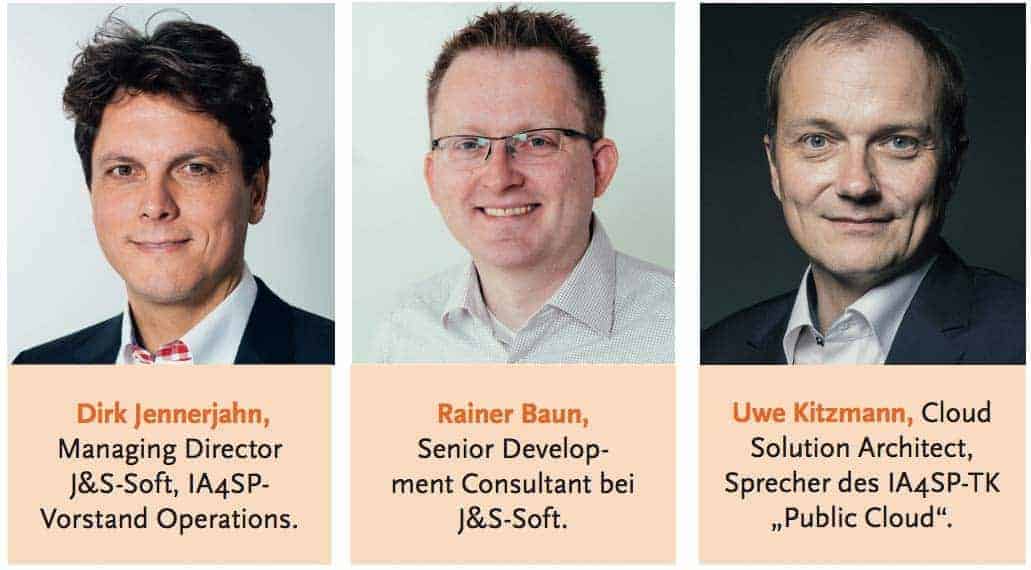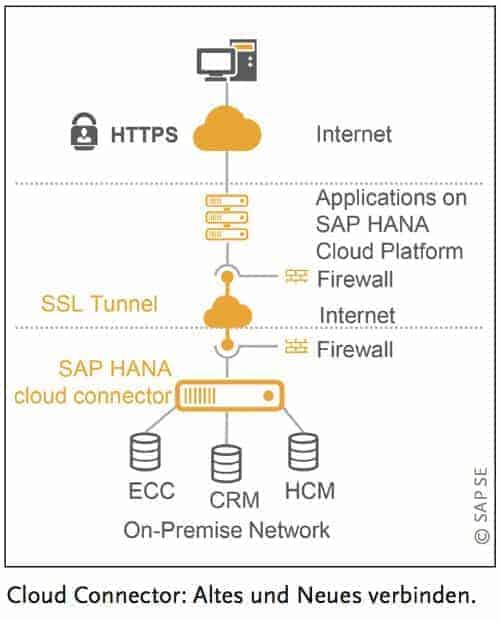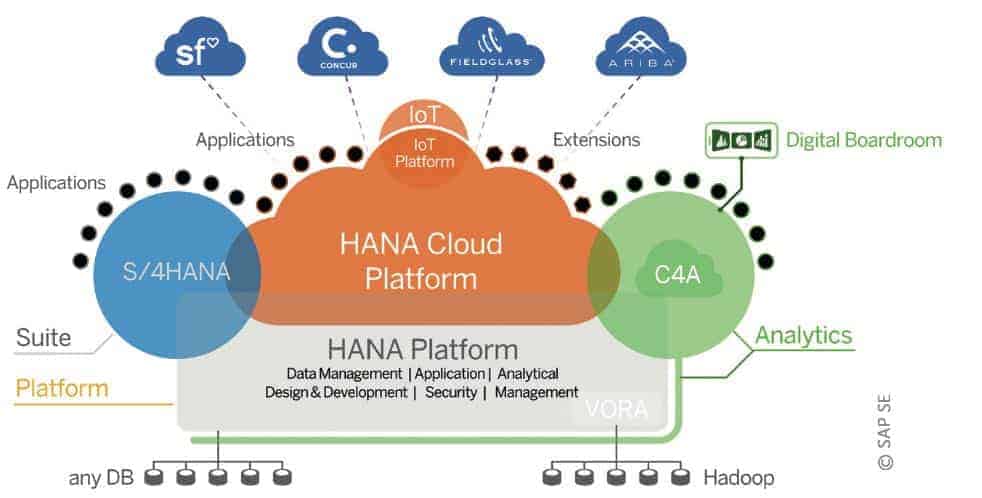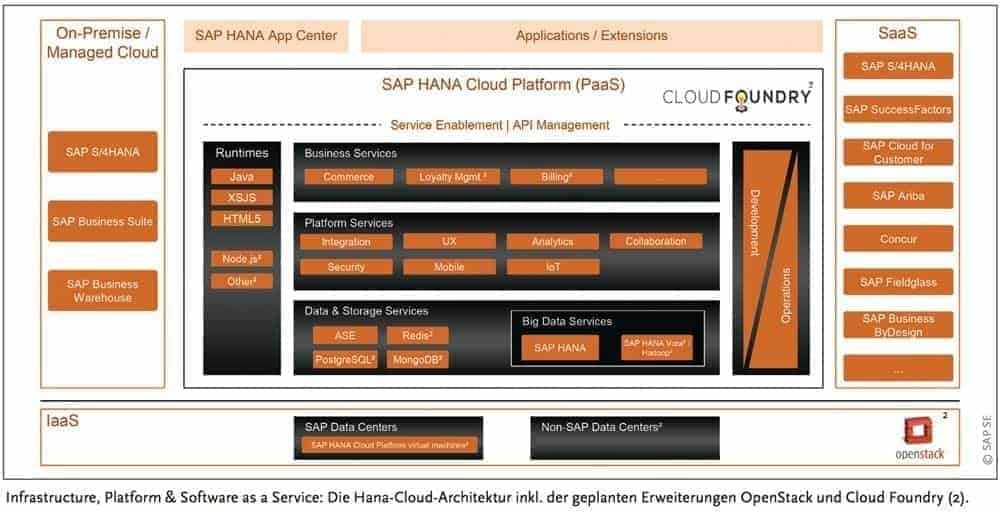HCP as a Service
![[shutterstock.com:571854583, Rawpixel.com]](https://e3mag.com/wp-content/uploads/2016/09/shutterstock_571854583.jpg)

The SAP Hana Cloud Platform (HCP) could be described as a binder for the technological development of products in SAP's core business.
The HCP is intended to ensure the integration of the classic SAP Business Suite with new SaaS (Software as a Service) products such as SuccessFactors or SAP Hybris Cloud for Customer. In addition, the renovated Business Suite (S/4) is to be offered a basis for extensions in the direction of the cloud.
However, the word "Hana" in the name still causes confusion among many customers because it puts the focus on SAP's in-memory database (IMDB).
On closer inspection, the Hana DB is an important pillar of the platform, but by no means a prerequisite for its use. The in-memory aspects do not necessarily have to be the goal when using HCP. Conversely, the Hana DB can also be operated without HCP.
In its product introduction, SAP refers to HCP as an "open in-memory PaaS (platform as a service) solution for the development and operation of business applications."
The services offered range from infrastructure-related services to pure business applications.
Here are some exemplary examples:
- Web IDE: browser-based development environment incl. GIT repository and layout editor;
- SAP Real Spend: Business application for budget management for managers;
- OAuth 2.0 Service: technical administration tasks for the OAuth Security Framework.
 In total, the platform currently offers around 30 to 40 services, with new ones being added all the time. The services are grouped into different areas. For example, a service such as SAP Real Spend is located in the Business Services area.
In total, the platform currently offers around 30 to 40 services, with new ones being added all the time. The services are grouped into different areas. For example, a service such as SAP Real Spend is located in the Business Services area.
The architecture overview from HCP's current product presentation illustrates this division of services, see figure.
Use cases & openness
The HCP is positioned by SAP as a development platform for two main use cases: Developing new cloud-based applications and extending existing on-premise and cloud applications.
Irrespective of the respective use case, SAP's HCP is oriented towards the paradigm of open standards. The path goes in the direction of Cloud Foundry and thus to the Bring Your Own Language (BYOL) approach.
Currently, HCP mainly supports the languages Java and JavaScript - the latter mainly in the context of SAPUI5 - and Hana Native, which is based on the application server Hana XS and requires the licensing of an HCP package including the Hana platform.
In addition to the development platform, the respective runtime environment is provided. Applications can be developed with multi-client capability (multitenancy). The SAP Store can be used as a sales platform.
SAP positions HCP as a universal extension platform for on-premise and cloud applications. Regardless of whether S/4 Hana or SaaS applications such as Fieldglass, Ariba, SuccessFactors or Concur are used.
Adaptations of the SAP standard are to be decoupled from the concrete application. This enables the enhancements to be largely release-independent and reduces unwanted correlations with the SAP standard.
Hana Cloud Integration or simply Hana Cloud Connector can be used as supporting middleware. This enables, for example, an encrypted connection of on-premise systems including user mapping.
As a universal enhancement platform, HCP opens up new business models for SAP development partners. In the past, customizations were mostly integrated directly into the backend as a customer program, but now the development of customizations can be decoupled, centralized and generally marketed.
Thanks to the now uniform UX strategy in the SAP universe (SAPUI5/Fiori), enhancements can also be seamlessly integrated from a usability perspective.
As described above, HCP serves as a kind of binder that connects the classic SAP world with new products. In this way, SAP continues to position the ERP successor S/4 Hana as the large mother ship around which various specialist solutions are located.
The HCP is intended to strategically replace old enhancement concepts as a universal enhancement platform. This will enable extensive independence of the development cycles of SAP enhancements, architectural decoupling from the solution to be enhanced.
SAP partner companies that have so far dealt with just such enhancements are opening up completely new business areas as a result. Extensions can be developed on a less customer-specific basis.
The sale of corresponding solutions is also being placed on a new foundation via the SAP Store. And integration channels such as Hana Cloud Integration will fill the gap between cloud and on-premise.
SAP is trying to expand its business in the midmarket in particular. New customers are often acquired via new cloud products such as SuccessFactors. Particularly with cloud products, the question arises as to how customers can implement enhancement requests.
And this is precisely where SAP's answer lies: HCP. SAP's philosophy is based on APIs (for example, OData APIs) of the individual SAP standard solutions, to which extensions hosted on HCP can dock.
A positioning of HCP as PaaS for non-SAP customers independent of other SAP solutions is currently not to be seen. The use as a platform for new solutions from ISVs (Independent Software Vendor) can be analyzed as an exception.
ISV & Innovation
HCP offers independent software vendors (ISVs) and especially SAP partners a platform on which new software solutions can be developed. SAP is thus once again trying its hand as a potential competitor in the market for technical platform providers.
Especially advantages of the optionally available in-memory technology and integration aspects with other SAP systems can motivate ISVs to use HCP.
Once again, SAP is putting its licensing policy in the way as an obstacle. The licensing of HCP is a multi-layered issue. Currently, the easiest way seems to be marketing via the so-called embedded Paas model (ePaaS).
This is an OEM model that enables SAP partners to sell their HCP solution as a complete package. The prerequisite for this is membership in the SAP PartnerEdge Program for Application Development including the Innovation Pack for Hana Cloud Platform.
SAP charges 25 percent of the subscription revenue and a minimum fee for the ePaaS. If one wants to take advantage of Hana services in particular (Hana XS, GeoSpatial Services, etc.), the monthly base price is at least 990 euros.
There are a number of useful scenarios for the use of HCP in the enterprise context. Of particular note are, first and foremost, the use cases that enable existing customers of SAP on-premise systems to detach sub-processes from the on-premise context and make them available as a standalone app in the cloud.
In this way, it is possible to establish new innovative concepts and functionalities for business users faster, in shorter development cycles and with agile process models.
In the order processing department of a manufacturing company, the company's employees can view the current status of an order via the ERP or CRM system. The end customer who placed the order does not have this option. Typically, a phone call or writing an email is necessary to get information about the current status of an order.
With a dedicated app, whether for mobile devices or desktops only, developed for HCP and integrated into the on-premise system, end customers can be provided with this information easily and quickly in self-service.
To develop applications of this type, a secure connection between cloud and on-premise is first necessary. For ERP and CRM systems, the Hana Cloud Connector provides this functionality, establishing a secure SSL VPN tunnel to the HCP infrastructure after installation in the backend.
In the HCP, appropriate configuration settings are then made in the designated Connectivity Services for all connections to third-party systems that are connected via the Hana Cloud Connector.
Among other things, it defines which services in the back-end system may be addressed by the Cloud Connector or - in other words - are on the whitelist for integration.
ERP or CRM backend systems that are connected via Connectivity Services can be directly addressed in Java applications on the HCP using JCo via RFC/BAPI function calls.
In addition, it is possible to provide endpoints for objects in the backend system via SAP Gateway-OData, which can be consumed directly via REST by Java, Hana XS and HTML5 applications. This method is often preferred as it provides more flexibility in the solution architecture of the cloud application.
Market companion
When you look around at the platform provider market for software development, you inevitably come across the three big offerings: Amazon Web Services (AWS), Microsoft Azure and Google Cloud Platform.
So why bother with Hana Cloud Platform and SAP as a provider in addition?
A comprehensive comparison of the various offers would go beyond the scope of this article, but we would like to highlight what we consider to be the key features of the offers mentioned.
Amazon, as a pioneer of cloud-based services, now offers a very large number of different services and launches new services practically every year. With AWS Lambda, for example, it is possible to execute one's own program code in a function event-based in the cloud in order to subsequently continue working with the result locally or with other cloud-based services.
In addition, from basic storage, DNS management, and identity management to frameworks for Hadoop and IoT services, AWS offers the complete portfolio for ISVs looking to leverage cloud-based services from a platform provider.
Microsoft has also invested heavily in the expansion of its cloud platform offerings in recent years and has now put together an attractive range. The focus at Azure is on Microsoft technology, such as SQL Server, Azure Search, Azure DocumentDB, Azure Batch in combination with a usage-based billing model.
Google Cloud Platform also offers a number of very popular cloud services, most notably App Engine and Cloud Storage. App Engine supports applications in Python, PHP and Go in addition to Java.
A special feature of App Engine is the automatic scaling of applications based on the degree of utilization, without the need to add further technical infrastructure components such as load balancers. All three of the providers mentioned offer a usage-based billing model for each service in the portfolio.
In contrast to AWS and Microsoft Azure, SAP HCP does not always have a clear target group profile for the platform. Given the diversity of services and the great variety, it is not easy to identify a specific usage scenario. The advantages over the market competitors are not immediately apparent.
In addition, the currently available services have very different levels of maturity. There are services that are still classified as "beta", services with a very simple range of functions, and even a mature web development environment such as the Web IDE. Without a publicly available roadmap, this results in uncertainties as far as strategic IT planning in companies is concerned.
A significant difference to other providers is the still missing tools for usage-based billing of the services used, in order to be able, for example, to also develop prototypes and POCs with comparable financial risk on the HCP. This also applies to ISVs that want to run their products on the HCP and offer them to their customers and bill them on a usage basis. Tools for resource accounting and distribution mechanisms across accounts are still completely missing.
With market competitors such as Microsoft Azure, the use of configuration tools and price calculators makes it relatively easy to understand what a solution will cost.
Conclusion & Licenses
HCP is still subject to strong customization as far as the licensing model is concerned, and there is a plethora of diverse packages, individual services and various dependencies per customer and deployment scenario. This makes it difficult for customers to assess their business case, and HCP is also priced in an opaque "cost cloud" that can easily range from 1000 to 50,000 euros per month.
According to SAP's plans, HCP will continue to develop both technically and functionally in the future. Technically, the transition to Cloud Foundry is intended to create a basis that will make it easier to expand HCP for additional runtime environments, databases and services. Operating the HCP in non-SAP data centers is also on the agenda.
The functional expansion consists of offering micro-services, such as those available to SAP with the acquisition of Hybris/YaaS. This means that more and more services are being added to HCP's Business Services area.
It remains to be seen how SAP will succeed in differentiating between these new services, SaaS products and the classic Business Suite. With HCP, SAP offers a PaaS platform that may also be of interest to non-SAP customers.






